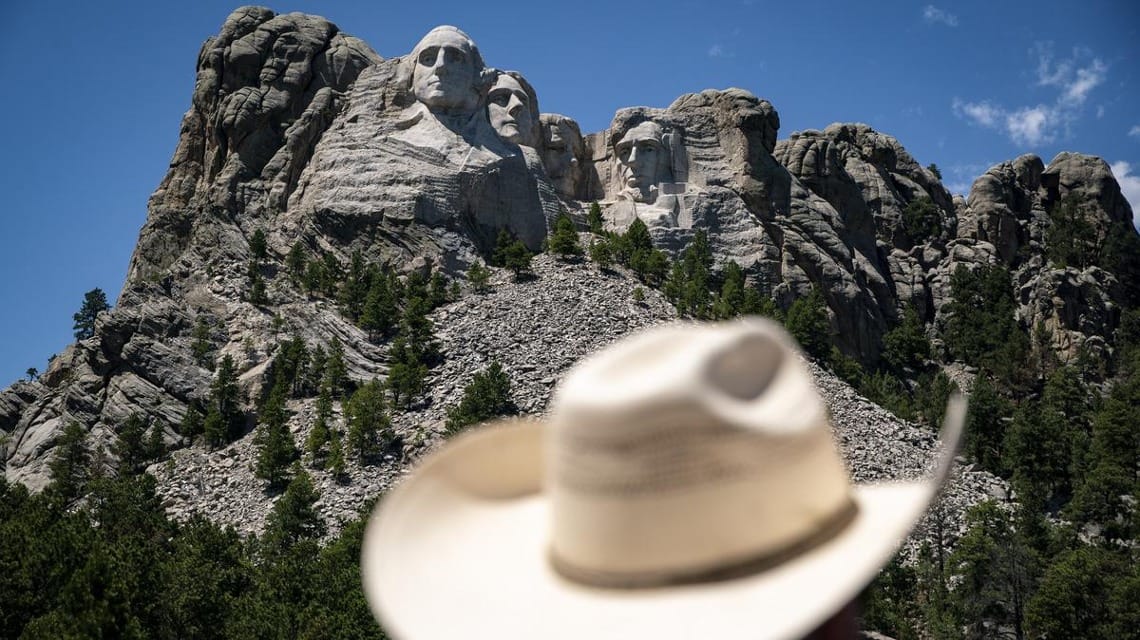What has been simmering in the dark arteries of these woods for almost a hundred and fifty years is the longest and most stubborn battle of native people against the American governmentthe resistance struggle for the redemption of the Black Hills, the black hills, stolen by the settlers.
These slopes covered with conifers and sprinkled with freshwater basins are not a piece of land like so many in the South Dakota; they are the He Sapa, the sacred lands of the Oceti Sakowin, (which rivals branded Sioux, the little snakes), the confederation of allied tribes Lakota, Dakota and Nakota. Here, the legendary Crazy Horse warrior was born; Sitting Bull and Red Cloud rode here. The land that fueled the pride of a people who did not even bow to the offer of one hundred and five million dollars, the price that the Supreme Court had set in 1980 to compensate for the illegitimate expropriation, which took place in the second half of the nineteenth century, when the whites took to the gold rush. A fund that has never been collected and has now risen to over one billion.
After decades of struggle, the natives, fenced off on the Pine Ridge Reservation, had placed high hopes on “friend” Biden; but the recent Russian attack on Ukraine threw the fear of a second descent in front of him. “We must adopt all the tools and technologies that can free us from dependence on fossil fuels (…) We must end the dependence on China and other countries,” the president said last March, invoking the Defense production act, a Cold War law to encourage the extraction of lithium and other materials for national security purposes. Increase the mines, therefore.
“Electric cars need lithium, uranium bombsExplains Carla Rae Marshall, activist of the Black Hills clean water alliance, the main association that monitors mining activities in the sacred hills of South Dakota. We meet her in her office in Rapid City. “This energy will be green for others, but for us it will have a devastating price because the Black Hills, with all the mineral reserves, are under fire once again. We are ready to fight again ».
Again, in fact. Because the Lakota Sioux have been fighting for survival ever since the whites “discovered” America and they began to grab every inch. Until then they were the only inhabitants of the Great Plains of the West, then fictionalized in dozens of Hollywood films. They lived thanks to bison hunting, the essential core of their livelihood. From the majestic “buffalo” they got food, skins for tents, fat to store, bones to make tools.
“We Lakotas say the Black Hills are the heart of everything that exists,” says Monique Mousseau, the local activist we travel with. Over two hundred kilometers long, with peaks reaching two thousand meters, this mountain range owes its name to the dense vegetation that makes it appear gloomy from afar, but beautiful and rich in nuances when you cross it. «For you it is land to be exploited; for us the hills instead represent the soul that feeds our spirituality, the connection with Mother Earth. A Lakota will always try to get back here, where he can hear and see them, “says Mousseau, pointing to them, after getting out of the car, as soon as they enter the Pine Ridge Reservation, one of the most economically depressed areas in the United States where forty-six thousand live. Lakota of the Oglala gang. “The colonizers left them there thinking they were of no use, unless they changed their minds when they discovered they were rich in gold“.
They had tried to trust the natives when in 1851 first and then in 1868, at the fort of Laramie, the American government signed a treaty with them promising that no one would touch the Black Hills. The good intentions of the pale faces did not last long, just long enough to discover the gold kept in the belly of the earth, after an exploration by General George Armstrong Custer in 1874. The black hills were invaded by miners and settlers, in defiance of all the treaties, so much so that the government canceled them in 1877. It was then that the tireless struggle of the Lakota to get back the “stolen” territory began.
However, exploitation continued into the 1950s, this time to extract uranium. In the seventies, the local opposition, but above all the collapse of prices, made the pumps stop. Today the only active is the Wharf Gold Mine. “They left, leaving hundreds of abandoned mining sites, some in the open, without reclaiming radioactive contaminated water or land,” says Marshall.
In the mid-2000s, rising uranium prices rekindled the ‘explorers’ torches. The Black Hills clean water alliance blows the neck of all companies that have applied for the necessary public permits. There are several vying to extract uranium, lithium, gold and rare earths. Clean water alliance points the finger in particular at the extraction projects of the Canadian-Chinese multinational Azarga / Powertech Uranium. “They would use huge quantities of water, over thirty thousand liters per minute, completely free.” There are billions of dollars at stake. “Fifty years ago no one was held responsible for the ecological damage. We will not allow that to happen again, ”promises the environmentalist.

A fight between David and Goliath, because the companies have been warming up their engines for years. Canada’s United Lithium is looking forward to an excavation project that, if approved, will occupy some 40 square kilometers in the Black Hills. “The mines of the 1970s did not employ our modern methods. We are excited, we expect discoveries capable of supporting the growing demand for lithium to supply the North American markets, ”said Michael Dehn, the president.
In the years following the Second World War, the black hills were a very important source of “white gold”. Today, despite substantial reserves in the United States, there is only one active mine and it is located in Nevada, again on sacred land.
America, which has given way to China, Australia, Argentina, feels it can no longer postpone the race. Lithium is needed for the production of telephones, computers, pharmaceuticals. And for electric vehicles, of course, which in 2030 are estimated to use 90 percent of the available lithium.
Of course, a tout court opposition remains difficult. “There are pros and cons,” reflects Professor Jim Stone, director of the environmental engineering department at Rapid City’s School of Mines and Technology: “If there was more stakeholder integration and if minerals were used for national use, this would be an ideal place to produce sustainable energy. First of all, there is not a large population in the surrounding area, but I understand that for the Lakota the problem is not only linked to pollution, but also to the sacredness of the territory ».
Biden’s energy policies are a gauntlet imposed by the times. Certainly not dictated by little consideration of the needs of indigenous peoples. Indeed, from the first day in the White House, with an executive order, the president imposed the blocking of the works of the Keystone pipeline, as Obama had done, while Trump had then given the green light. In word and deed, with the appointment of Native American Prime Minister Deb Haaland, for example, to the Interior, Biden has made it clear that respecting the self-government of tribal peoples is a priority of his administration. He then allocated billions to help the reserves tackle the drought, clean up the mines and stop the consequences of the pandemic, which are terrible for the Indians. In short, a reversal of the trend of the Democrat compared to the Republican predecessor.
To Trump, the Lakotas will never forgive the sgarro of having wanted to celebrate Independence Day in 2020 at the foot of Mount Rushmore, the most famous tourist attraction in the Black Hills, with the big faces carved into the rock of Presidents Washington, Jefferson, Roosevelt and Lincoln (each in their own way involved in the oppression). American marketing promotes it as the sanctuary of democracy. For the natives it is the symbol of white oppression. Two years ago, the Indian protesters, who came to tell Trump that he was not welcome, were heard shouting, ironically: “Go back to your home.”
Organizing the protests was Nick Tilsen, soul of the Ndn collective, arrested during a demonstration. He is the face of the He Sapa return campaign, which has seen a revival even following the Black Lives Matter season. “There is a global movement for the return of land to the natives. The entire economic system of the United States was founded on the holocaust of our people and on slave labor. They tried to finish us off, but we’re still here. The spirit of resistance runs in the blood of our people, it’s the same as Crazy Horse, ”says Tilsen. The collective aims to create a trust that would allow him to work with the Department of the Interior to manage the land, now mostly federal property. Nick recalls: “We’ve always refused government money for the Black Hills, it’s time they gave it back.” The visceral relationship with these places cannot be monetized: “The Black Hills are not for sale and neither are the Lakota people.”
The struggle of the Native Americans to save the Black Hills from lithium hunting

